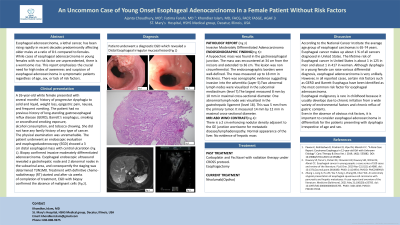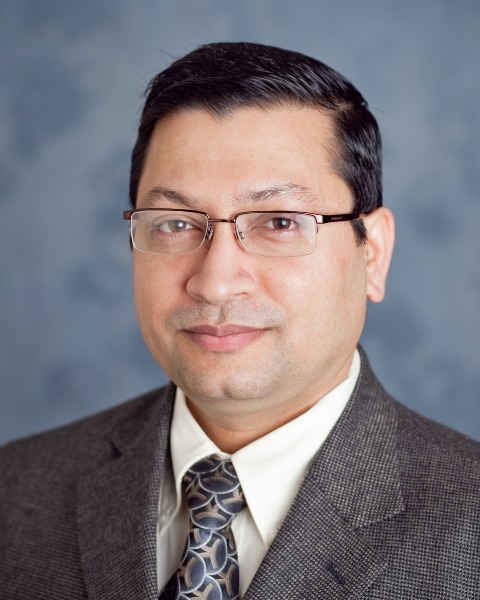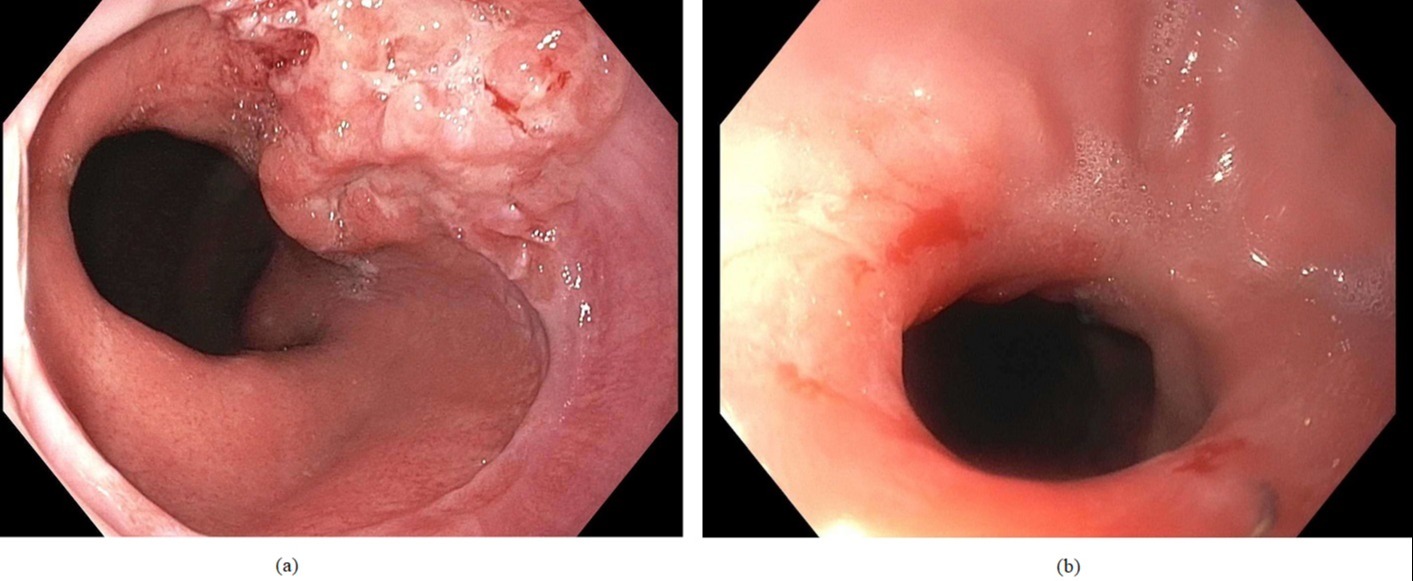Sunday Poster Session
Category: Esophagus
P0465 - An Uncommon Case of Young Onset Esophageal Adenocarcinoma in a Female Patient Without Risk Factors
Sunday, October 22, 2023
3:30 PM - 7:00 PM PT
Location: Exhibit Hall

Has Audio

Khondker Islam, MD
HSHS St. Mary's Hospital
Forsyth, IL
Presenting Author(s)
Ajanta Choudhury, MD, MBBS1, Fatima Farahi, MBBS2, Khondker Islam, MD3
1Dhaka Medical College and Hospital, Ventura, CA; 2Foundation University Medical College, Leesburg, VA; 3HSHS St. Mary's Hospital, Decatur, IL
Introduction: Esophageal adenocarcinoma, a lethal cancer, has been rising rapidly in recent decades predominantly affecting older males at a ratio of 8:1 compared to females. While cases of esophageal adenocarcinoma in young females with no risk factor are unprecedented, there is a worrisome rise. This report emphasizes the crucial need for high index of awareness and suspicion of esophageal adenocarcinoma in symptomatic patients regardless of age, sex, or lack of risk factors.
Case Description/Methods: A 26-year-old white female presented with several months’ history of progressive dysphagia to solid and liquid, weight loss, epigastric pain, nausea, and frequent vomiting. The patient had no previous history of long-standing gastroesophageal reflux disease (GERD), Barrett’s esophagus, smoking or secondhand smoking exposure, alcohol consumption, and tobacco chewing. She did not have any family history of any type of cancer. The physical examination was unremarkable. The patient underwent an endoscopic evaluation and esophagogastroduodenoscopy (EGD) showed a 3 cm distal esophageal mass with central ulceration (Figure 1(a)). Biopsy confirmed invasive moderately differentiated adenocarcinoma. Esophageal endoscopic ultrasound revealed a gastrohepatic node and 2 abnormal nodes in the subcarinal area, and consequently the staging was determined T3N1M0. Treatment with definitive chemo-radiotherapy (RT) started and after six weeks of completion of treatment, EGD with biopsy confirmed the absence of malignant cells (Figure 1(b)).
Discussion: According to the National Cancer Institute the average age group of esophageal carcinomas is 65-74 years [1] Although dysphagia in a young female can raise various differential diagnosis, esophageal adenocarcinoma is very unlikely to strike the mind. However, in all reported cases, certain risk factors such as GERD and Barrett Esophagus have been identified as the most common risk factor for esophageal adenocarcinoma [2]. Even in the absence of obvious risk factors, it is important to consider esophageal adenocarcinoma in differentials for the patients presenting with dysphagia irrespective of age and sex. On a brighter side, this case presents an opportunity to explore possible treatment response in young patients with locally advanced disease.
1. SEER Cancer Stat Facts: Esophageal Cancer. National Cancer Institute. Bethesda, MD, https://seer.cancer.gov/statfacts/html/esoph.html
2. Zhang Y. Epidemiology of esophageal cancer. World Journal of Gastroenterology. 2013;19:5598.

Disclosures:
Ajanta Choudhury, MD, MBBS1, Fatima Farahi, MBBS2, Khondker Islam, MD3. P0465 - An Uncommon Case of Young Onset Esophageal Adenocarcinoma in a Female Patient Without Risk Factors, ACG 2023 Annual Scientific Meeting Abstracts. Vancouver, BC, Canada: American College of Gastroenterology.
1Dhaka Medical College and Hospital, Ventura, CA; 2Foundation University Medical College, Leesburg, VA; 3HSHS St. Mary's Hospital, Decatur, IL
Introduction: Esophageal adenocarcinoma, a lethal cancer, has been rising rapidly in recent decades predominantly affecting older males at a ratio of 8:1 compared to females. While cases of esophageal adenocarcinoma in young females with no risk factor are unprecedented, there is a worrisome rise. This report emphasizes the crucial need for high index of awareness and suspicion of esophageal adenocarcinoma in symptomatic patients regardless of age, sex, or lack of risk factors.
Case Description/Methods: A 26-year-old white female presented with several months’ history of progressive dysphagia to solid and liquid, weight loss, epigastric pain, nausea, and frequent vomiting. The patient had no previous history of long-standing gastroesophageal reflux disease (GERD), Barrett’s esophagus, smoking or secondhand smoking exposure, alcohol consumption, and tobacco chewing. She did not have any family history of any type of cancer. The physical examination was unremarkable. The patient underwent an endoscopic evaluation and esophagogastroduodenoscopy (EGD) showed a 3 cm distal esophageal mass with central ulceration (Figure 1(a)). Biopsy confirmed invasive moderately differentiated adenocarcinoma. Esophageal endoscopic ultrasound revealed a gastrohepatic node and 2 abnormal nodes in the subcarinal area, and consequently the staging was determined T3N1M0. Treatment with definitive chemo-radiotherapy (RT) started and after six weeks of completion of treatment, EGD with biopsy confirmed the absence of malignant cells (Figure 1(b)).
Discussion: According to the National Cancer Institute the average age group of esophageal carcinomas is 65-74 years [1] Although dysphagia in a young female can raise various differential diagnosis, esophageal adenocarcinoma is very unlikely to strike the mind. However, in all reported cases, certain risk factors such as GERD and Barrett Esophagus have been identified as the most common risk factor for esophageal adenocarcinoma [2]. Even in the absence of obvious risk factors, it is important to consider esophageal adenocarcinoma in differentials for the patients presenting with dysphagia irrespective of age and sex. On a brighter side, this case presents an opportunity to explore possible treatment response in young patients with locally advanced disease.
1. SEER Cancer Stat Facts: Esophageal Cancer. National Cancer Institute. Bethesda, MD, https://seer.cancer.gov/statfacts/html/esoph.html
2. Zhang Y. Epidemiology of esophageal cancer. World Journal of Gastroenterology. 2013;19:5598.

Figure: (a) Endoscopic evaluation reveals 3 cm distal esophageal mass with central ulceration (b) Post-treatment confirmation: EGD reveals no residual malignancy after chemo-RT completion.
Disclosures:
Ajanta Choudhury indicated no relevant financial relationships.
Fatima Farahi indicated no relevant financial relationships.
Khondker Islam indicated no relevant financial relationships.
Ajanta Choudhury, MD, MBBS1, Fatima Farahi, MBBS2, Khondker Islam, MD3. P0465 - An Uncommon Case of Young Onset Esophageal Adenocarcinoma in a Female Patient Without Risk Factors, ACG 2023 Annual Scientific Meeting Abstracts. Vancouver, BC, Canada: American College of Gastroenterology.
